#Dry Food Storage Container
Text

Vittles Vault Dog Food Storage Container, Up To 35 Pounds Dry Pet Food Storage, Made in USA
#Dry Pet Food Storage#Pet Food Storage#BestDogFoodStorage#PetCare#HealthyPets#DogLovers#PetWellness#Gamma2 Vittles Vault Dog Food Storage Container
0 notes
Text
#forklift container#dry storage#laundry carts#storage bins#commercial storage#food industry#poly box#containers#storage containers
1 note
·
View note
Text

#interior design#kitchen#canisters#glass#storage#containers#dry food#sustainable#slow living#slow home#zara home#peaceful dwellings
0 notes
Link

#Food storage bins#dry food storage bin#food bin for hotel#Kitchen Storage Bins Supplier#Grain Storage Containers
0 notes
Text

#Made from a high-quality food-grade stainless steel container which ensures strength#quality#and durability. Switch over to Stainless Steel Long-Lasting Containers for storage. Leave the old plastic storage boxes that easily break a#Sugar#Coffee powder#Spices#Dry fruits#Biscuits#Candies#Namkeen & Cooking Essentials fresh for a long time. Made with high strength good airtight performance#cold & heat resistance#acid & alkali resistant#and superior corrosion resistance. These are crafted keeping in mind the utility#usefulness#and comfort of the customers along with elegant looks. Dishwasher safe. Great for kitchen cabinet and pantry storage organization and ideal#https://www.maximaworld.in/
0 notes
Text
Femme Fatale Guide: Products & Services Worth The Save (or Saving On)
Fashion:
Socks (I love the HUE ones that come out to around $3 per pair)
Tights (another vote for HUE – around $10-13 dollars a pair and should last at least a season or two with proper care)
Layering tanks & tees
Underwear (buy them on a bulk deal – I love Skims' 3/$36 [on the pricier end here] – or getting luxury items on sale, especially pair from Natori or Hanky Panky [usually come up to around $10-$15 a pair]; Parade also has $6 underwear that's great quality for the price)
Trendy items
Costume jewelry (Mejuri, Aurate, and Justine Clenquet are great for the price; Catbird is the best in the game for a moderate-priced alternative to luxury jewelry in my opinion)
Beauty:
Cleanser
Facial Toner
Makeup Wipes
Acne Spot Treatment
Mascara
Brow Gel
Setting Powder/Spray
Shampoo & Conditioner
Body Wash
Body Scrubs
Hand/Body Lotion
Hand Soap
Vaseline (use it as a lip treatment, cuticles, dry skin patches, or as a hydrating eye cream)
Lip Balm (Palmers SPF 15 is my HG)
Makeup Sponges/Spoolies
Hair Ties
Home:
Lighting
Home Decor
Artwork (I have mostly Black & White photography from iCanvas and get so many compliments on them!)
Coffee Maker (a Black & Decker coffee maker or a French Press is all most people need)
Everyday Dishes & Glassware (I love Sweese, Smilatte, and Luigi Bormioli on Amazon)
Dishwasher-Safe Reusable Food Storage Bags/Snack Bags
Produce Saving Containers
Health & Wellness:
Deva Vitamins/Supplements
Fitness Youtube Workouts
Bulk-buying Oats, Beans, and Other Staple Foods
Frozen Fruits & Vegetables (when not in season, especially)
Listening to Podcasts via Youtube
TED Talks
Services:
Facials
Blowout
Dermaplaning
Teeth-Whitening
Mani-Pedi
Professional/Social:
Owning your full name social handles across platforms
Simple Investment Planning (Roth IRA, HSA, 401K - anything involving index funds)
Get a great headshot (many colleges and universities offer their students/alumni headshots for free)
Cash-back & Travel-miles $0 Fee Credit Cards
#femmefatalevibe#girl talk#girl tips#girl advice#girl blogging#femme fatale#dark femininity#dark feminine energy#it girl#high value woman#dream girl#queen energy#female power#high value mindset#female excellence#the feminine urge#glow up#level up journey#high class#classy life#elegance#product recommendations#healthylifestyle#health & fitness#fashion and beauty#life advice#life tips#etiquette
422 notes
·
View notes
Text
Food - use or toss?
All of us have looked at a food item wondering if it is too old to eat. Most of the time, if we are not sure, we throw the item in the trash. Adding to the confusion are the “best by”, “sell by” and “use by” dates on food packages in the US. I found some information to help with those decisions, allowing us to safely reduce food waste in our homes.
According to the US Department of Agriculture, “Food poisoning bacteria does not grow in the freezer, so no matter how long a food is frozen, it is safe to eat. Foods that have been in the freezer for months may be dry, or may not taste as good, but they will be safe to eat.” In addition, “most shelf-stable foods are safe indefinitely. In fact, canned goods will last for years, as long as the can itself is in good condition (no rust, dents, or swelling). Packaged foods (cereal, pasta, cookies) will be safe past the ‘best by’ date, although they may eventually become stale or develop an off flavor. You’ll know when you open the package if the food has lost quality. Many dates on foods refer to quality, not safety. See FSIS’ Shelf-Stable Food Safety fact sheet for more information.” The US Department of Agriculture is collaborating with the Food Marketing Institute and Cornell University to update the online Foodkeeper storage guide, which contains storage information on a wide variety of foods.
The website https://www.eatortoss.com/ provides information on many unusual food safety questions, in addition to more general guidance. For example, the website discusses what to do if one strawberry in a container is moldy or if your celery is floppy. The website also includes “use it up” recipes to help clean out the refrigerator or pantry.
70 notes
·
View notes
Text
@dyrujuz submitted: Hello :]
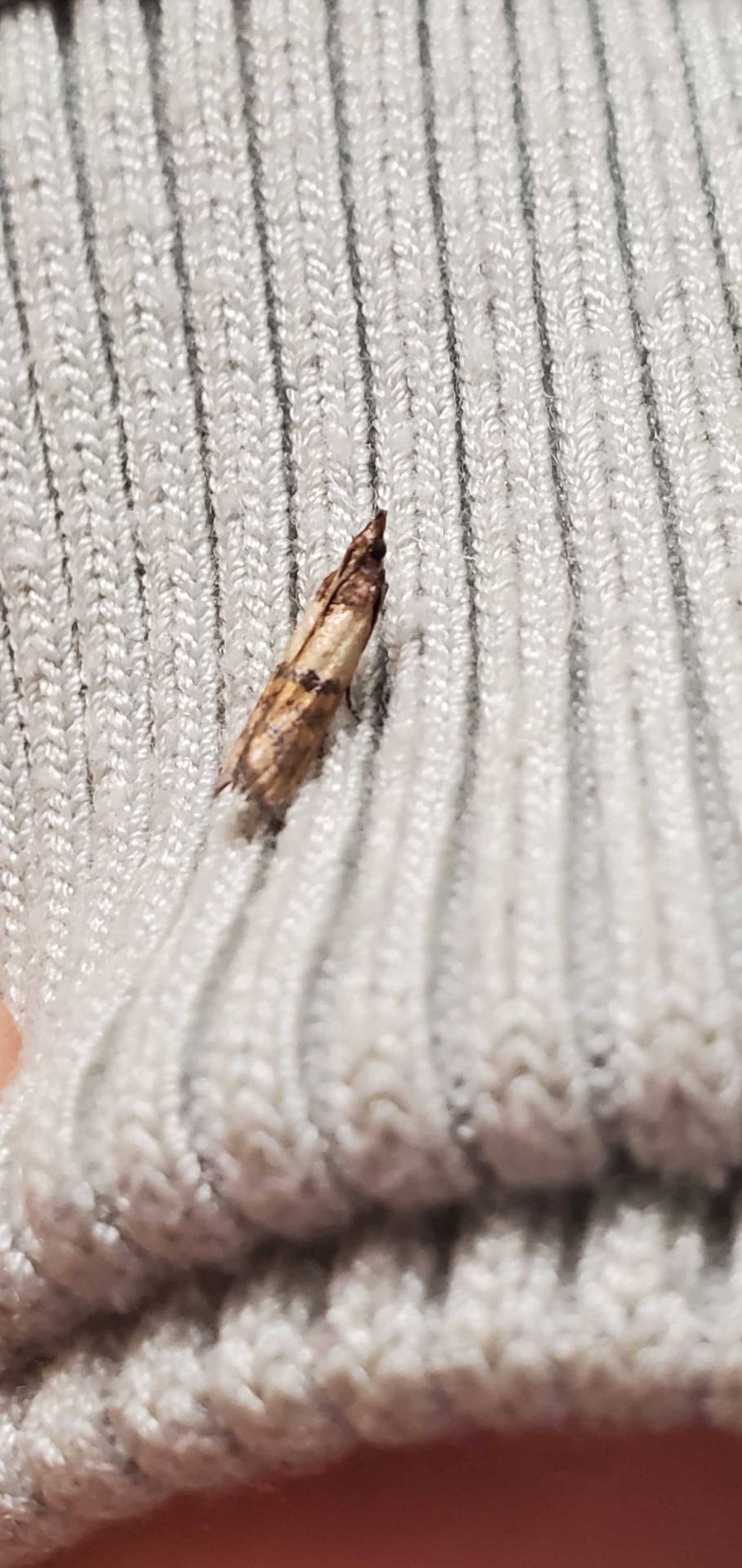



These fellas seem to be taking over the shelter I work at and I was wondering what they are. Pictures were taken in [removed] (please remove the location) and are these potential concerns for the animals here
Ps love your blog :]
Hi! Thank you! These are Indian meal moths, Plodia interpunctella, which are common pests in dry/stored plant-based foods like grains, nuts, and cereals. They especially love things like birdseed or other plant-based dry pet food, so it makes sense they'd show up in a shelter.
They're not outright dangerous to animals and don't transmit disease but if there's a large infestation they can spoil the dry food stores if they introduce moisture and bacteria. But if you open a bag of birdseed or whatever and there are a few larvae but the seed still looks dry and mostly whole and isn't a writhing mess of larvae, it's still fine. They can chew through cardboard and soft plastic so the only safe storage containers would be thick plastic, metal, or glass.
86 notes
·
View notes
Text
Drying Herbs
How to Dry Herbs

Drying is the easiest method of preserving herbs. Simply expose the leaves, flowers or seeds to warm, dry air. Leave the herbs in a well ventilated area until the moisture evaporates. Sun drying is not recommended because the herbs can lose flavor and color.
The best time to harvest most herbs for drying is just before the flowers first open when they are in the bursting bud stage. Gather the herbs in the early morning after the dew has evaporated to minimize wilting. Avoid bruising the leaves. They should not lie in the sun or unattended after harvesting. Rinse herbs in cool water and gently shake to remove excess moisture. Discard all bruised, soiled or imperfect leaves and stems.
Dehydrator drying is a fast and easy way to dry high quality herbs because temperature and air circulation can be controlled. Pre-heat dehydrator with the thermostat set to 95°F to 115°F. In areas with higher humidity, temperatures as high as 125°F may be needed. After rinsing under cool, running water and shaking to remove excess moisture, place the herbs in a single layer on dehydrator trays. Drying times may vary from 1 to 4 hours. Check periodically. Herbs are dry when they crumble, and stems break when bent. Check your dehydrator instruction booklet for specific details.
Less Tender Herbs — The more sturdy herbs such as rosemary, sage, thyme, summer savory and parsley are the easiest to dry without a dehydrator. Tie them into small bundles and hang them to air dry. Air drying outdoors is often possible; however, better color and flavor retention usually results from drying indoors.
Tender-Leaf Herbs — Basil, oregano, tarragon, lemon balm and the mints have a high moisture content and will mold if not dried quickly. Try hanging the tender-leaf herbs or those with seeds inside paper bags to dry. Tear or punch holes in the sides of the bag. Suspend a small bunch (large amounts will mold) of herbs in a bag and close the top with a rubber band. Place where air currents will circulate through the bag. Any leaves and seeds that fall off will be caught in the bottom of the bag.
Another method, especially nice for mint, sage or bay leaf, is to dry the leaves separately. In areas of high humidity, it will work better than air drying whole stems. Remove the best leaves from the stems. Lay the leaves on a paper towel, without allowing leaves to touch. Cover with another towel and layer of leaves. Five layers may be dried at one time using this method. Dry in a very cool oven. The oven light of an electric range or the pilot light of a gas range furnishes enough heat for overnight drying. Leaves dry flat and retain a good color.
Microwave ovens are a fast way to dry herbs when only small quantities are to be prepared. Follow the directions that come with your microwave oven.
When the leaves are crispy dry and crumple easily between the fingers, they are ready to be packaged and stored. Dried leaves may be left whole and crumpled as used, or coarsely crumpled before storage. Husks can be removed from seeds by rubbing the seeds between the hands and blowing away the chaff. Place herbs in airtight containers and store in a cool, dry, dark area to protect color and fragrance.
Dried herbs are usually 3 to 4 times stronger than the fresh herbs. To substitute dried herbs in a recipe that calls for fresh herbs, use 1/4 to 1/3 of the amount listed in the recipe.
Copyright: This document was extracted from "So Easy to Preserve", 6th ed. 2014. Bulletin 989, Cooperative Extension Service, The University of Georgia, Athens. Revised by Elizabeth L. Andress. Ph.D. and Judy A. Harrison, Ph.D., Extension Foods Specialists.
Picture Credit: Linda Palmer- Pinterest.
#witch#hearth witch#herbal magick#kitchen witch#small business#witch blog#etsy shop#herbs#kitchen witchery#pagan#witchy#witchcraft#witchyvibes#green witch#pagan witch#witch community#witchblr#witch aesthetic#witchcore#witches#witchlife#hellenic pagan#paganism#pagan community#paganblr#wicca
222 notes
·
View notes
Text

35 Bottles From the 18th Century Filled with Cherries Found at George Washington’s Mount Vernon
The story of a six-year-old George Washington chopping down a cherry tree may be a myth, but archeologists excavating Mount Vernon, the home of the United States’ first president, made the very real discovery of 35 glass bottles filled with cherries and berries.
The bottles were found in five storage pits in the mansion’s cellar, with 29 of them intact and containing “perfectly preserved cherries and berries, likely gooseberries or currants,” according to a news release from George Washington’s Mount Vernon on Thursday.
Crews unearthed the 18th-century bottles during the ongoing $40 million revitalization project launched last year at Mount Vernon, Virginia.
The bottles were extracted from the pits and refrigerated, and are expected to undergo scientific analysis, the release states.
The slowly drying bottles, “composed of materials and foodstuffs that are likely 250 years old,” will be sent from Mount Vernon’s archaeology lab to an off-site location for conservation, according to the release.
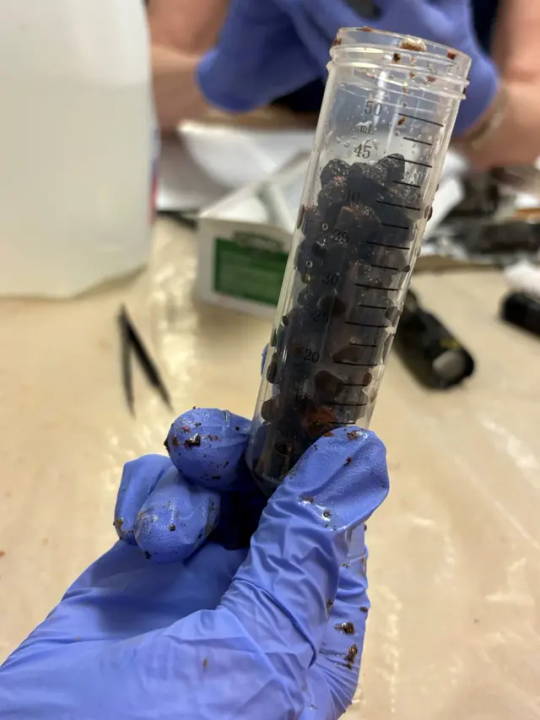

The latest discovery comes after the recent find of two intact European-manufactured glass bottles, also from the 18th century, filled with liquid, cherries and pits in the same cellar, according to the organization.
“Now we know those bottles were just the beginning of this blockbuster discovery,” Mount Vernon President and CEO Doug Bradburn said in a statement.
Bradburn referred to the discoveries as “an unprecedented find,” adding that “nothing of this scale and significance has ever been excavated in North America.”



“The bottles and contents are a testament to the knowledge and skill of the enslaved people who managed the food preparations from tree to table,” said Jason Boroughs, Mount Vernon principal archaeologist.
The bottles may have been forgotten when Washington left Mount Vernon to take command of the Continental Army, according to Bradburn.
“These artifacts likely haven’t seen the light of day since before the American Revolution,” he said. “It’s so appropriate that these bottles have been unearthed shortly before the 250th anniversary of the United States.”




Bradburn added that the organization’s team is hopeful the cherry pits may be viable for future germination.
Mount Vernon partnered with the US Department of Agriculture’s Agricultural Research Service to analyze the bottles’ contents.
In the early stages of analysis, researchers identified 54 cherry pits and 23 stems, suggesting the bottles were likely full of cherries at one point, according to the release.
“The cherries likely are of a tart variety, which has a more acidic composition that may have aided in preservation,” the release states.
The cherries are likely candidates for DNA extraction, which could help researchers compare them against a database to identify their exact species, according to the release.
By Ashley R. Williams.

#35 Bottles From the 18th Century Filled with Cherries Found at George Washington’s Mount Vernon#mount vernon#George Washington#glass#glass bottles#18th-century bottles#ancient artifacts#archeology#archeolgst#history#history news
36 notes
·
View notes
Note
do you have any good suggestions for keeping humidity in an enclosure sky high (like, 80% bare minimum)? i've heard daily misting does wonders and i know some substrate helps better then others, but do you have a more specific answer?
I'm actually not the biggest fan of misting - unless you've got a very reliable misting system set up, it can be easy for misting to cause dips and spikes in humidity levels and you really want your humidity to stay consistent.
Here's how I maintain tropical humidity levels:
Picking the right enclosure is critical! You can maintain high humidity in screen-top enclosures but that'll be a lot more work for you. For small snakes or babies, plastic tubs are perfect; for adults, PVC is a good material choice.
Choose a good humidity-retaining substrate. Coconut husk is my go-to; it can get dusty when dry but you shouldn't let it get dry. It's very easy to rehydrate by simply dumping water directly into it.
Provide a large water bowl! An easy trick is to add another water bowl on the hot side of the enclosure; as it evaporates, it'll release extra moisture into the air.
Make sure your snake always has access to a humidity box! They can be easily made by cutting a hole in the lid of a food storage container big enough for your snake to fit inside and filling it with damp moss.
Once you've got your enclosure set up with humidity-retaining substrate and nice big water bowls, it's honestly just a matter of maintenance. Use a good hygrometer with a probe, and rehydrate the substrate when you top up the water. I only ever need to mist my tropical enclosures when those snakes are shedding!
104 notes
·
View notes
Text
Antarctic Food
Below you will find my account of eating at McMurdo, but PBS did a whole special on it which has more privileged access and, like, moving pictures and stuff. I highly recommend watching that if you're at all interested in the food question.
As other pleasures in life are restricted or eliminated, food gains significance beyond mere nutrition. When removed from the comforts and diversions of civilisation for months or years at a time, polar explorers had to pay particular attention to the culinary side of their enterprise. Scott learned this the hard way on the Discovery, when their cook was so bad he was sent home after the first year and others took over his job in shifts. Shackleton, on his second visit to Antarctica, brought all sorts of tinned delicacies, and left a lot of them behind in his hut at Cape Royds, which the Terra Nova men would raid on day trips from Cape Evans. Scott was much more careful with his choice of cook on his second expedition, and in his journal he continually praises Clissold's cooking – though Atkinson, writing for a publication he knew no one would read, says that Archer (the ship's cook, who filled in after Clissold was invalided home) was a far superior chef, and made the miserable second winter that much more bearable.
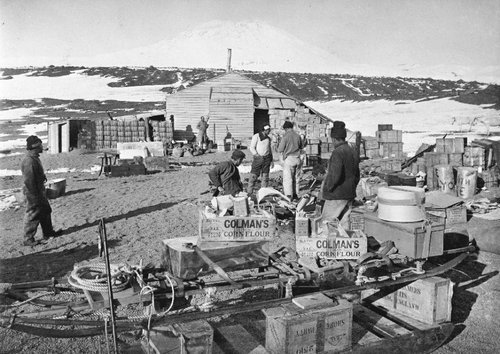
The expeditions of the early 20th Century brought down crates and crates of imperishables – tinned vegetables, powdered milk and eggs, and dry goods like flour, sugar, and tea. These were necessary, of course, but were ultimately supplemental to the core of their diet, which was the produce of Antarctica itself. In fact, in a letter laying out contingency plans if the Terra Nova Expedition were stranded in Antarctica, Scott says not to worry for their safety because the continent provides enough food to keep a party happily fed; they would only be wanting the comforts of a civilised menu. Mostly what the continent provided was seals, whose meat (especially livers) contained enough Vitamin C to stave off scurvy, but penguins and their eggs also regularly passed through the kitchen, and the contents of the marine biologist's net – once properly enumerated and dissected, of course – would often end up in the frying pan. The Notothenia fish was commonly eaten at breakfast, appreciated for its 'sweet' and 'nutty' flavour. Notothenia’s claim to fame is the sugar in its blood that acts as an antifreeze, so this is hardly a surprise.
Thanks to the Antarctic Treaty forbidding the killing of animals for consumption, modern Antarctic larders are not stocked with local wildlife, and as far as I know, no one down there now has tasted the sweetness of Notothenia. They do, however, have the advantage of modern transport and food storage, not to mention a century's worth of advances in the study of nutrition, so the diet of the present-day Antarctican is fresher, healthier, and much more diverse.
McMurdo Station's annual food supply arrives in one lump delivery, every January, on a big cargo ship from California. From the harbour where the Discovery berthed, it goes into climate-controlled storage, either to the dry goods store or to the freezer, which is a whole building off the cafeteria in the main station hub. A freezer, in Antarctica? Why, yes, because food safety regulations require frozen food to be kept at a constant temperature, and the only way to ensure that is to build an enormous manmade freezer in the land of ice and snow. In the summer, temperatures at McMurdo will wander around freezing, so this is entirely practical, but for much of the year, it's actually warmer inside the freezer than outside.
The modern Antarctic commissariat is not entirely divorced from its Edwardian predecessor, though – frozen vegetables taste fresher than tinned, and are more nutritious and palatable, but they are not fresh; powdered milk and powdered eggs are still the status quo. During the summer, perishable groceries – called 'freshies' – come down on the flights from New Zealand, if there is room after the passengers and equipment are loaded. After a month of flight cancellations, fresh apples and oranges are greeted with as much delight as they were on the arrival of relief ships in the Heroic Age, and the appearance of a salad bar in the Galley prompts general rejoicing.
The US Antarctic Program has its roots in the Navy, and McMurdo is still provisioned by one of the big firms that supplies the US military. Having had experience with industrial-scale American catering in California, I had moderate expectations of the quality of food at McMurdo, but it was surprisingly good. One might argue that the excitement of being there and the daily energy expenditure would be a good sauce for anything, and this may be true, but against this I would argue that dry air impedes one's ability to taste – that fact it was so flavourful at all is significant. People kept apologising for the food in the Galley and I kept telling them, earnestly, that it was better than the food in the Disney commissary. They didn't believe me, but I firmly attest this; I ate at Disney on my return journey and have confirmed it by direct comparison. I know they were working with roughly the same quality of ingredients, but the chefs at McMurdo reliably made things delightful to eat, which is more than I can say for the other place. Why this should be is anyone's guess ... Working as a Galley Rat is one of the few ways enthusiasts can get down to the Ice, so it's full of keen, intelligent, and curious cooks, and maybe that rubs off on the food. There are people who come back to tackle the unique challenges of Antarctic cuisine year after year, so maybe they're more experienced and invested in the job. My personal theory is that because they have to eat the food, too, of course they're invested in making it tasty – I suspect the folks behind the counter in LA have much better meals waiting for them when they get home.
Mealtimes follow a strict schedule:
5:30-7:30 Breakfast (many a time I missed the cutoff, woe)
11:00-13:00 Lunch
17:00 to 19:30 Dinner. There was always a portion of the cafeteria serving breakfast food at this time; this was reserved for the night shift workers, who got a reprise of the day shift's dinner for their lunch. If you really liked whatever was served for dinner, nothing could stop you coming around again for another go at midnight.
The one exception to this was Sunday, when a brunch would be served from 10 to 12. The service in the chapel started at 10 as well, and was very weak competition. Brunch was always excellent, and being the single day off, was often where one would meet up with people who were too busy during the week.
If you failed to make a mealtime for any reason, there was always something on offer. A fridge would be stocked with packaged leftovers, sandwiches, and other food-to-go – when I had a day out, I would eat breakfast and then grab my lunch from this fridge. On one occasion, dinner included fried okra (one of my faves, rarely had outside the States) and after stuffing myself with it, I nabbed two or three extra portions and cached them in my dorm room mini-fridge to enjoy later.
In a challenging environment, with a lot of people doing energy-intensive jobs, calories are important. There was only one rule regulating portions: Take what you want, but eat what you take. With a finite amount of food on hand, and delivery only once a year, food waste is anathema – if you need it, then eat it, but do not throw any away.
The menu seemed to originate with whatever presented itself in the enormous freezer, though perhaps in November and December it was dictated more by what remained in it, prior to the new shipment. We didn't suffer for want of variety, though: if anything, we benefited from a surfeit of prawns, including great bowls of them at Sunday brunch. I found myself wondering if the US military had a contract for most of the catch from the Gulf, and how much of their famously inflated budget went into that; I suspect, in reality, the kitchen just hit a seam of prawn in the recesses of the freezer and had to use it up. As a devotee of all shapes of sea bug, I was in seventh heaven, and did my level best to help McMurdo clear the surplus.
Once new food was defrosted and cooked up, it would cascade through various dishes down the week, as leftovers were repurposed to minimise waste. Usually this was successful, but sometimes they had to try a little harder ...

A variety of cuisines were offered, some of which were more successful than others. They seemed to reflect the makeup of the US military, for whom the rations would have been designed. The best dishes were the meat-and-potatoes variety (my minder said that if she were on Death Row, she'd ask for McMurdo Pot Roast for her last meal), Italian, Southern (see above re: okra), and what I assume was Tex Mex – the only misstep on the last count was an almost inedibly hot 'taco soup' which may have been more of a delivery vehicle for leftovers than an intentional dish. The only disappointments were anything attempting to be Asian, and the fish, which, due to the circumstances, was always overcooked. Provision was always made for vegetarians and even vegans, but I can't say I noticed many people adhering strictly to those diets. I suppose if the animals are already dead and in the freezer, there's little difference whether you eat them or not.
There was also, always, pizza. It was left in one of those tiered heated racks like you get at a buck-a-slice takeaway pizzeria, but this was no buck-a-slice pizza, this was McMurdo pizza, and McMurdo pizza is AMAZING. My brother-in-law's cousin went to super legit pizza school in Naples, and gets queues down the street wherever he opens a pizzeria. He makes the best pizza I have ever had anywhere; McMurdo’s wasn't quite as good as his, but it was pretty darn close. It's a testament to how good the rest of the food was that I didn't just have pizza for every meal. The pizza kitchen runs 24 hours a day, and takes orders for pickup from all across the base. If you're flying out to a field camp, it's good manners to take their pizza order and deliver it to them hot and fresh. For all the advances in food technology since the Heroic Age, surely the greatest has to be the McMurdo Pizza.
We were reminded constantly how important hydration was, and the Galley offered a range of liquids at all hours. To my surprise, what looked like a soda fountain offered not pop but fruit juice – grapefruit, orange, cranberry, and apple, though one or more often ran out before the end of breakfast. There were enormous urns of extremely weak coffee – a provision, I supposed, for its diuretic effects – though with 10-hour workdays and very early starts, a little more oomph would have gone a long way. Experienced hands, and those of discerning tastes, brought their own coffee or sourced it somehow from the stores. The kitchenette in the Crary library was full of people's personal coffee-making supplies as they sought a more effective brew.
I had been warned that if I liked tea, I should bring my own; this was a sound warning, as the black tea on offer looked and smelled as though it had been on a shelf for about a decade. What I had not been warned about was that the only 'milk' on hand for one's coffee or tea was, in most places, 'coffee whitener', a ubiquitous Americanism which I'd completely forgotten about (or supressed?) since moving away. For those who've not had the privilege of its acquaintance, this is a blend of margarine, sugar, synthetic vanilla, and titanium dioxide, rendered into a powder by some unknown chemical process and packaged up to pass for milk. (I think it might be illegal in Europe. I've certainly not seen it around.) The Galley had the base's only dispenser of actual mammalian lactation – reconstituted from powdered, of course. If I were to go again, I would bring a small bottle to fill there with 'real' milk, which I could take away for tea purposes elsewhere. There were boxes of UHT milk available for purchase in the shop, and had I been staying longer I might have invested in some, but for just a splash per cuppa, it hardly seemed worthwhile.
The undisputed star of the Galley was the soft serve ice cream dispenser, named Frosty Boy (or Boi), an ancient beast that was such an institution that it was rumoured the USAP had bought another one from a junkyard just for parts. The Thing to Do was, instead of putting milk or coffee whitener in your coffee, to use a dollop of Frosty Boy instead – I'm not sure which end of the dairy/non-dairy spectrum his product was nearest, but it did go well in the coffee, such as it was. More often than not while I was there, Frosty Boy exuded only a watery splutter rather than creamy delight – even when he was working, the product was rather gritty – but I was assured he was just going through a phase, and would be right again soon. I got the impression that if anyone tried replacing the machine with something more reliable, or which produced something more resembling ice cream, there'd be a protest. We shall see if Frosty Boy survives the station revamp, as the NSF seems keen to scrub out any vestiges of character ...
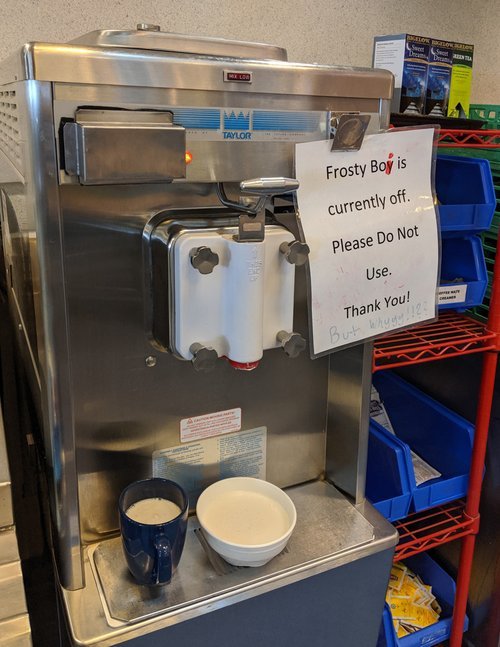
I have brought two things back from the McMurdo Galley, and they're things that go right back to the beginning: powdered milk and powdered egg. Even when I'm near a shop with both in fresh form, it's convenient to have the powdered on hand for recipes. I really only use milk to splash in my tea and coffee, so don't keep a large amount in my fridge, but recipes often call for far more than I have – so instead of making a trip for the extra, I can just mix it up on demand. I've also taken on the Perpetual Yoghurt: McMurdo makes its own yoghurt from its vast reserves of powdered milk, using a bit of the last batch to inoculate the next, and it turns out this is perfectly doable at home, too. Eggs eaten as eggs are better fresh, of course, but when providing structure in a recipe, no one's going to notice if they've been reconstituted, and then I can save my 'real' eggs for when they'll be appreciated. It's a good system, and economical, too. Alas, the pizza isn't as easy to replicate at home ...
For more information on McMurdo food –
The Antarctic Sun newsletter put out this podcast: https://antarcticsun.usap.gov/features/4329/
I didn't mention how good the desserts were; I was lucky enough to share my time at McMurdo with Rose McAdoo, who was featured in this story on NPR: https://text.npr.org/779463164
162 notes
·
View notes
Text
Quick n dirty Hurricane post
Hurricane Shopping List
Food:
The government will tell you that you need 3 days of food, you need at least a week. After Ian we were flooded for about 4 days and had no power for 8. You want non perishables and you want tasty non perishables, get things you and your family like. Keep your eye out for sales through the year to keep a good stash.if you don’t have a grill, Get a mini charcoal grill so you can also still cook
Soups
tuna and other canned meats
Ramen (fun, not nutritious)
Snacks like chips and crackers, salsa!*
Single serving sauce packs (go hog wild at fast food places)
Cereal
Fresh fruit
Pasta sauce and pasta
Bread and shelf stable toppings like jelly* and peanut butter
Treats! It sucks, get some gummy bears, get BEER!
Instant coffee
*these aren't technically shelf stable,but yes they are lol, at least for a few days, sugar and acid are both preservatives, if it looks funny, don't eat it, but they'll be fine for a few days
Everything in your freezer will be good too, at least for a while. Eat everything in your fridge first, but after a few days, if you are going to lose everything in your freezer anyway, open it up and start using meats etc in there.
Water:
There are 4 categories for water, Drinking, cooking, cleaning, and flushing. ** if you do not have hot water, you need to be using bleach or vinegar or everything that gross. Hot water is our best friend and if we do not have her we need to kill every germ, without proper plumbing there are bad germs everywhere.
Drinking: half gallon to gallon per person per day
Cooking: A gallon per day, more if you have a larger family
These two need to be in sanitized containers intended for water storage, so bottled water, or food grade 5 gallon containers, tractor supply has good ones, or the huge water jugs at the grocery store.
Cleaning***: as much as you can, personally i start saving every 2 liter, OJ bottle, milk jug etc from about January to hurricane season so i can fill them all up when a storm is on the way. This doubles as you-cleaning water, so the more the better
Flushing: as much as physically possible. Fill up every tub, every sink, fill up your trash cans. I am 100% serious you WILL run out of flushing water before anything else. Literally as much as possible.
Misc items:
Battery banks, whether proper banks, or your laptop to use as a bank
A full tank of gas, never go under half a tank during hurricane season
This radio is great
Proper first aid kit (you should already have one tbh)
Any medications you need, check your state laws to see if you can get emergency prescription refills
Toys, books, any kind of entertainment really, it gets boring, couldnt imagine being a toddler.
Extra pet food
Baby wipes
Extra period products
Corn starch is a decent dry shampoo
General tips:
Find a radio station with a morning show, find several. There was a group in my area that was broadcasting 24/7 taking calls from people with trucks and people who needed help or medicine. They saved lives.
Park your cars as high as possible, and as close to your house as you can
It is so much better to feel silly with all this stuff than to be caught off guard
Lock your pets in a non carpeted room if you can.
Do laundry!!!!!
Shower and scrub every square inch a few hours before the storm starts, wash your hair!!!
Have 2 weeks of undies
Check on your neighbors
DO NOT GO INTO FLOOD WATERS WHY DO PEOPLE DO THIS THIS IS HOW YOU GET HEPATITIS
Have a plan for if it floods, have important docs and some food in a bag ready to go. If you are in an attic without a way to break through the roof, you will drown.
30 notes
·
View notes
Text
Simple Tips
Store fruit and veggies whole. This will allow them to keep longer, as their surface degrades faster when it has been cut and exposed to air – makes sense, right?
Handle your fruit and veggies gently, as bruises and cuts will lead to rotting which can also spread to other veggies stored nearby.
10 Rapidfire Veggie Storage Tips
#1 Leafy Greens
Lettuce, spinach, rocket, kale and chard can be stored in a sealed container or reusable produce bag in the fridge after being washed and spun to promote hydration.
#2 Tomatoes, Chilli & Capsicums
Fresh tomatoes, chillies and capsicums should be stored on the bench at room temperature until ripe. To preserve for longer, just pop them in the fridge.
#3 Garlic, Onions & Potatoes
Store in a cool dark place and they will keep well for up to a few months. Hint: don’t store potatoes with onions and garlic, as they release gases that may quicken decay.
#4 Pumpkins or Squash
Whole pumpkins can be stored for months in a cool, dry place out of direct sunlight. Sliced pumpkin should be stored in the fridge with the seeds removed, as these decay faster than the flesh.
#5 Cucumbers, Zucchini, Eggplant & Fennel
These immature fruits have thin skin that is sensitive to bruising and cuts, so handle carefully. Store them dry in the fridge in an unsealed reusable bag to allow for airflow.
#6 Carrots, Celeriac & Parsnip
Storing them in a reusable bag in the fridge with their tops removed will allow them to last for over a week (or longer).
#7 Beetroot, Turnips & Radish
Remove the leaves as soon as you get home to preserve the moisture within the roots (keep the leaves for compost or to feed your chickens or worm farm). Store the roots in a reusable produce bag in the fridge.
#8 Cabbages, Broccoli & Cauliflower
As broccoli and cauliflower are the unopened flower buds of a plant, they are best consumed within 3 to 4 days, before they begin to open and turn yellow. Store them in a crisper in the fridge in a reusable bag. Cabbages, however, will last for weeks.
#9 Celery & Soft Herbs
Celery and soft herbs such as parsley, chives and basil can be stored in a jar of water on the kitchen bench at moderate room temperature. Otherwise, in hotter months they can be washed and wrapped in a damp tea towel in the fridge.
#10 Dry Herbs
Dry herbs such as rosemary, thyme and oregano can be stored on the kitchen bench. The flavour becomes more potent as the herb dries, allowing them to keep for a long time. Once fully dry, seal in a container to sprinkle over your food later.
#txt#zero waste#mindful consumption#mindful living#slow living#soft living#plant based lifestyle#wfpb#adulting#life hacks#sustainability#eco conscious#ecofeminism#wellness lifestyle#holistic leveling up#leveling up#that girl#green juice girl#vegan#raw vegan#whole food plant based#nutritarian#seasonal living#sidewalkchemistry
141 notes
·
View notes
Text
Kitchen post today~
With prices being what they are I like a good deal on groceries when I can find it. Sometimes that leads me to buying large quantities of things.
This week the local scratch n dent market had 5 pound bags of golden potatos on sale, 2 for $4. We like potatos so I snagged a few bags. Since i had 2 from last week's groceries I decided to pick through them all.
I tossed a few rotten ones and sorted out the good from the ones getting on the going side. The good ones I put up in a storage tote (a cooking pot for now) for later cooking.
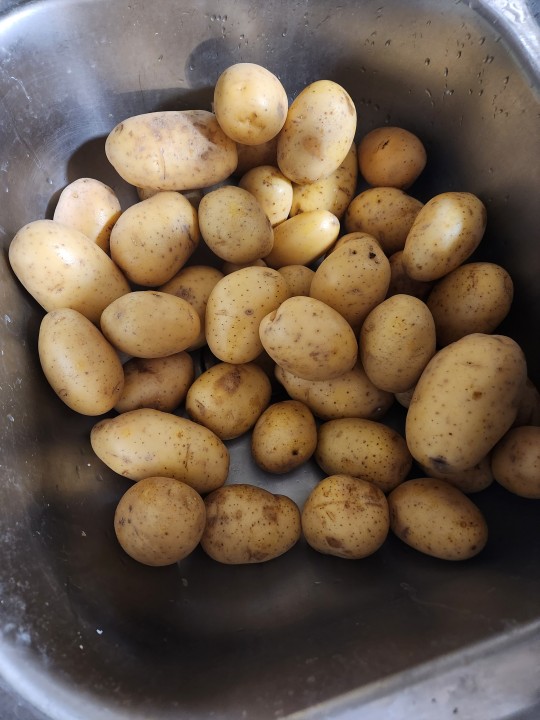
These ones are the contenders for the weekly meal/freezer prep. They had some funny or funky spots, things that can be cut off and thrown away or in the compost. I clean them after washing them well.
As a heads up, it's not suggested to feed chickens raw potatoes. So leave anything with raw potato bits in the trash or the compost bin.
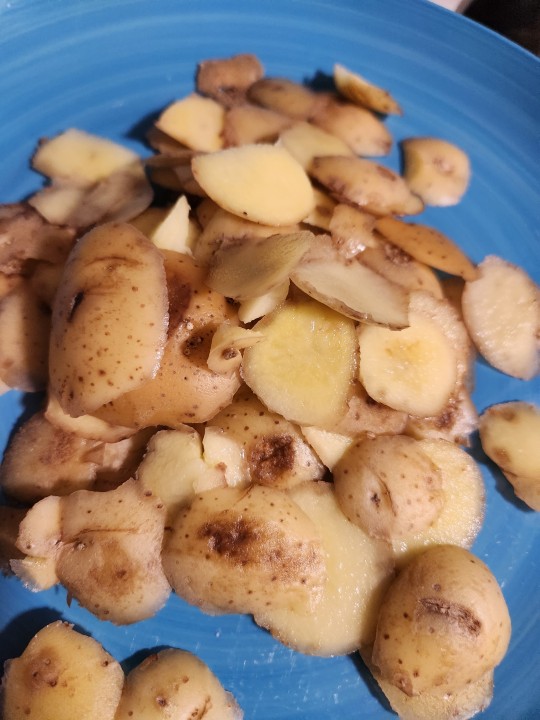
The bad bits.
If you feel need to you can wash them up again. I move to peeling after words.
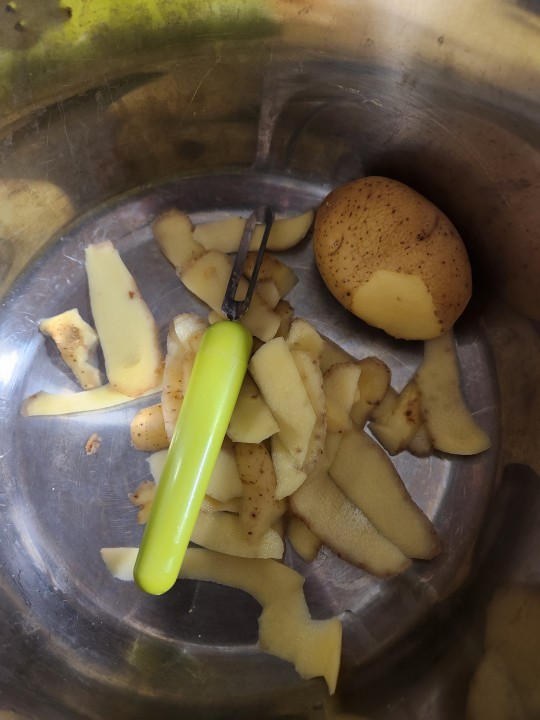
I save the peels for breakfast potatoes, or to make soup.
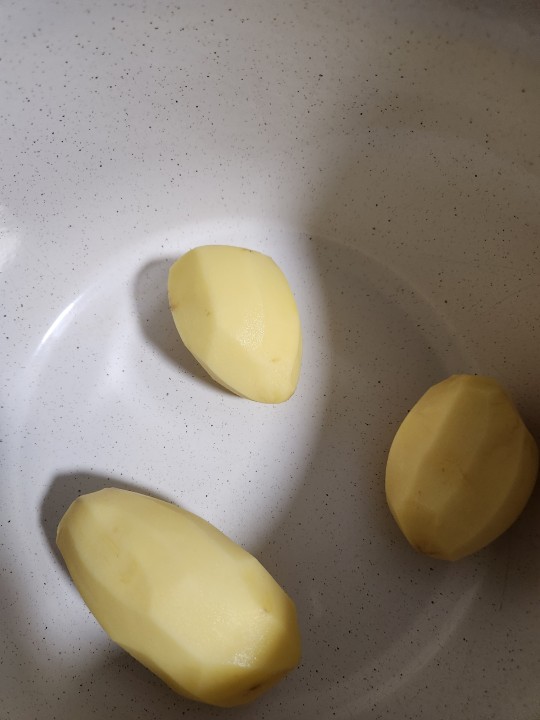
A few peeled spuds.
Afterwords, depending on how many potatoes needed to be processed will decide what im making. This time I had enough potatoes to do cubed potatoes and hashbrown potatoes.
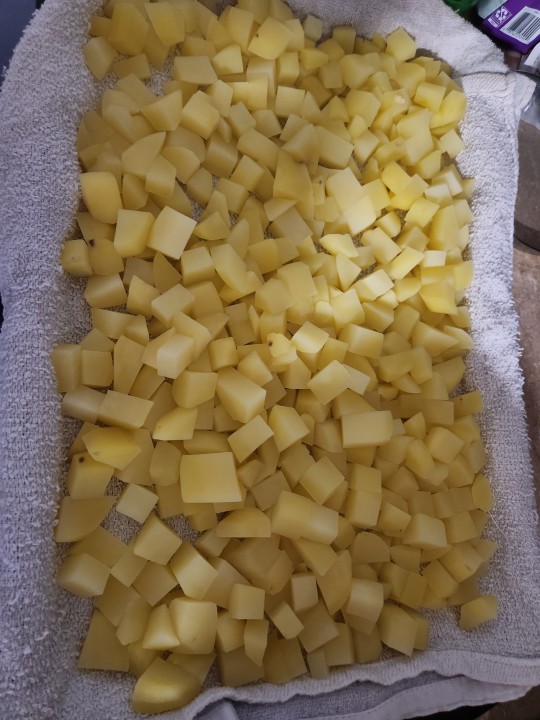
Cube potatoes, then blanch them till all Dante in a pot. (Not quite to mash potatoes softness, but not crunchy.)
Drain, cool quickly. (If your into water conservation, save the water for your plants once cooled) I cool till just under warm and lay them out to drain/dry a bit.
Then take a pan and lay out a clean kitchen towel on it. Pour dry potatoes on and place in freezer till frozen.
Store in container and use like regular frozen potatoes.
Moving to hashed potatoes
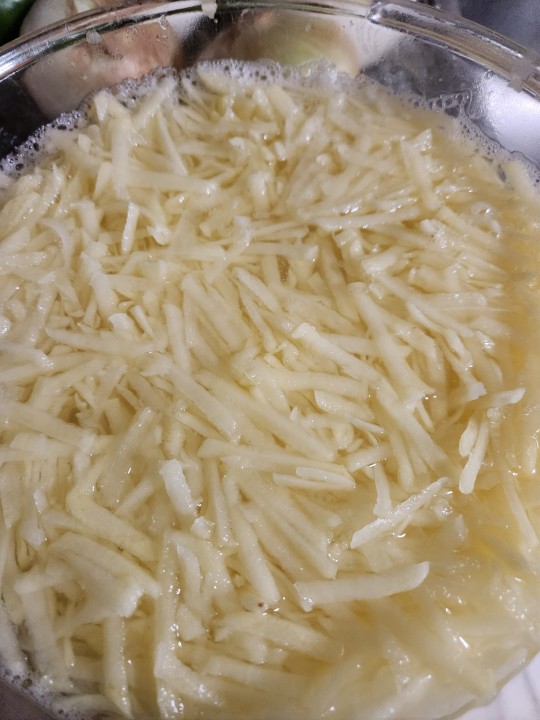
Similar to the cubed potatoes except I grated them.
I like to destarch my potatoes a little so I do a soak for about an hour, drain and then blanch.
I did about 5 minutes to blanch the hash, every couple minutes fish out a peice and test it to see if it's crunchy or just firm. Drain, cool asap.
Lay out to drain and dry a bit.
Lay towel on baking sheet. Place drained hashed potatoes on top. Place in freezer and freeze a few hours.
When frozen package up. Date and use as necessary :)
Other potato freezing/preserving resources
https://www.bbcgoodfood.com/howto/guide/how-to-freeze-potatoes
https://www.motherearthnews.com/real-food/dehydrate-potatoes-for-various-uses-zbcz1507/
🥔🌱Happy Homesteading!🌱🥔
#homesteading#self sufficient living#thestudentfarmer#studentfarmer#self sufficiency#food#garden#gardening#low waste#potato#sustainability#kitchen economics#resources#kitchen#food preservation#preserving freezer#preserving potato#simple eating#urban homesteading#urban farming#rooter to tooter#tip to tail#snout to tail#scrap cooking#budget cooking#small scale solutions
98 notes
·
View notes
Note
I’m moving into college in 3 weeks have you got any tips :0
yes!! quite a few actually. :) *for mutuals outside of the u.s., this advice is based on a U.S. American university experience, so some of it may not apply to you.
PLEASE SEND ASKS if you have specific questions, and I’ll either speak from my own experience or give information from other friends in university rn!!
packing:
You don’t need to bring ALL your stuff. (Really, it’s okay. Also, you have limited space.)
A quick Google search of “college packing list 2023” will yield many results. It’s up to you to decide what “essentials” are actually essential, but suffice it to say, think about the things you use on a daily basis and then think about what you don’t have at home that you’ll need in student housing.
Apartment or dorm, unless you’re really lucky—you’ll be sharing living space & appliances with other people. Yes, that includes showers. If you can get toiletries cheaper locally than in the location of your university, save yourself the time and money. Shower shoes are an absolute must, because those showers can get disgusting.
If you have a meal plan that lasts the entire year, you don’t really need to pack a bunch of food (or go grocery shopping a ton during the school year) but it can be nice to have dry goods & snacks on hand. (I keep rice, macaroni & cheese, crackers, & some type of dried fruit around, if nothing else. Whatever tastes strike your fancy, feel free to add/substitute.) If you’re cooking all your own food, you’re going to need at least a cooking pot, frying pan, spatula, dish sponges, and dish soap, as well as some resealable food storage containers and cheap cups and bowls (I got most of that at Target. They tend to have back-to-school sales and bowls & cups go for less than a dollar each.)
Laundry is going to be a pain in the ass, unless again, you luck out and have a washer and dryer in-unit. Ditto for dishes (unless your space comes with a dishwasher). Do yourself a favor & get a huge bin of Tide pods, pack of laundry sheets, & at least two paper towel rolls so you don’t have to run out every week to replenish cleaning supplies. (I personally despise having dish towels to wash, so if you don’t mind them take the paper towel advice with a grain of salt.)
My dorm was weird and had a sink in it. If you’re responsible for cleaning your own sink it will get nasty quickly. Either take turns with your roommate(s)/housemate(s), or figure out who the designated sink cleaner is.
friends/socializing:
Your first friend group in college will likely not be your last, nor will it last. This group is usually composed of people close in proximity to you aka convenience friends. You might realize three or four months in that these are not your people and you don’t like hanging out with them. This is perfectly normal and okay! You’ll find people who you do vibe with. I encourage you not to limit making friends to your specific university, although if you go to a small one like I do that can be tough.
Universities often have events with free stuff, including free food. Take advantage of these events if & when you can. They’re usually very laid back, and if you’re not in the mood to stick around, you can grab food and then dip.
Orientation events & icebreakers within your first week are to be expected. Try to remember a fun fact about yourself (which is what you usually get asked, along with your intended major, name, pronouns—sometimes, & hometown).
Your RA(s) aren’t cops, but they also aren’t your friends. They’re required to report sketchy shit that happens. My RAs had a rule that if they didn’t hear, see, or smell anything suspicious, it was like nothing happened, but try to get a feel for what yours look out for.
It is more than okay to need/want therapy. You’ve just gone through a massive change in your life and you did it mostly, if not all, by yourself. Your university counseling services (if applicable) are generally not the best place to go for therapy, though. This is especially true if you’re worried about your privacy. I don’t think I’ve heard of student discounts for therapy, but some therapists have this policy called sliding scale where you pay what you can. Find a person you can talk openly with and who is experienced with your mental health concerns/practices the right kind of therapy for you. (CBT, DBT, & EMDR are a few examples.)
dating, love, etc.
First and foremost, if this section doesn’t apply to you because you don’t participate or aren’t ready to in college, please feel free to skip!
If you’re still here, obviously I am not the expert on your love life—you are. That being said, without getting too personal, here are some things I’ve picked up through trial and error.
If you’re starting college, and haven’t yet dated anyone, it’s okay to feel behind. What isn’t okay is being patronized or taken advantage of for your lack of experience. I wish I could say it’s just common sense, but it’s crucial to figure out what your boundaries, limits, & standards are before getting into an intimate situation with somebody. (I myself learned this the hard way.)
simply put: It is okay to be picky! (Read that again.) Or not—what works for one person won’t work for everyone. Some people date & hook up just for fun, especially during college when a lot of changes are happening, and that suits them fine. Some people want stronger, longer connections, and that works for them. Some people focus on friends over partners and refrain from the entire dating & hookup scene. All are valid and healthy. (As long as you stay safe, sane, & consensual, and get tested.)
school stuff:
Please do yourself a favor and don’t schedule 8am classes five days a week. I don’t care if you could do it in high school—chances are you’re going to need to wake up way beforehand to get ready OR your roommate will do something ridiculous in the middle of the night that will wake you up. In this more than likely event, you won’t want to wake up and go straight to class. If you’re not a STEM major, this advice is easier than if you are (and if the first applies, my condolences and much love).
You need sleep no matter what—if that means midday naps, go for it. I don’t recommend skipping class to nap unless it’s an emergency though.
Re skipping class: some professors take attendance and your grade can suffer if you don’t attend. Aside from mental health days, skipping class for fun can be a slippery slope at some universities. (At some, Cs get degrees and grades don’t matter as much, especially if you aren’t looking to go down the postgrad path.)
#college#university#uni#universidad#college tips#college advice#general advice#asks#answered#school#studyblr#ref#host posts
141 notes
·
View notes